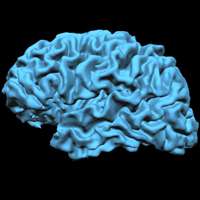November 27, 2012 report
Researchers find reading uses the same brain regions regardless of language

(Medical Xpress)—A team of French and Taiwanese researchers has found evidence to indicate that people use the same regions of the brain when reading, regardless of which language is being read. In their paper published in the Proceedings of the National Academy of Sciences, they describe how fMRI brain scans made while people were reading revealed that there are very few differences in how the brain works as reading occurs.
The researchers note that previous research has suggested that different neural networks might be involved when people read text written in very different types of languages. French, for example, is an alphabetic language, whereas Chinese is logographic. Those of Roman origin are based on abstract concepts while Chinese characters are based on realistic depictions of handwriting strokes.
To learn more, the researchers ran fMRI scans on volunteers reading either Chinese or French material as their native language. The material presented was shown in various forms, e.g. normal, static, backwards or distorted. The researchers also employed priming, which is where words are flashed on a screen for such a short period of time as to be unknown to the reader. Priming has been found to influence the rate at which readers recognize words that are shown thereafter for a normal duration of time. The material written in French was presented as cursive rather than block printed letters.
Prior research has shown that when people read, two main brain processes are involved: one involves processing the shapes of letters or characters to recognize them, the other recreates the physical movements that went into creating the images that are being read.
In analyzing the results, the researchers found the differences in brain activity between the two groups as they read to be minimal. Those differences that were found, centered around a slight increase in the brain regions associated with processing the physical movements that had occurred in creating the characters, which in the brain is recognized as motor skills.
The researchers suggest that their results indicate that because reading is a relatively new process for the human brain, it likely evolved using previously existing neural network circuitry, which would explain why it appears the brain works in roughly the same way when reading, regardless of language.
More information: Universal brain systems for recognizing word shapes and handwriting gestures during reading, PNAS, Published online before print November 26, 2012, doi: 10.1073/pnas.1217749109
Abstract
Do the neural circuits for reading vary across culture? Reading of visually complex writing systems such as Chinese has been proposed to rely on areas outside the classical left-hemisphere network for alphabetic reading. Here, however, we show that, once potential confounds in cross-cultural comparisons are controlled for by presenting handwritten stimuli to both Chinese and French readers, the underlying network for visual word recognition may be more universal than previously suspected. Using functional magnetic resonance imaging in a semantic task with words written in cursive font, we demonstrate that two universal circuits, a shape recognition system (reading by eye) and a gesture recognition system (reading by hand), are similarly activated and show identical patterns of activation and repetition priming in the two language groups. These activations cover most of the brain regions previously associated with culture-specific tuning. Our results point to an extended reading network that invariably comprises the occipitotemporal visual word-form system, which is sensitive to well-formed static letter strings, and a distinct left premotor region, Exner's area, which is sensitive to the forward or backward direction with which cursive letters are dynamically presented. These findings suggest that cultural effects in reading merely modulate a fixed set of invariant macroscopic brain circuits, depending on surface features of orthographies.
© 2012 Medical Xpress













